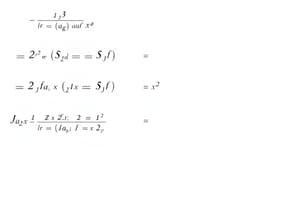Podcast
Questions and Answers
How does the role of the hippocampal region index change as a memory ages?
How does the role of the hippocampal region index change as a memory ages?
- It initially helps form the memory, but becomes less important over time. (correct)
- It shifts from storing general details to highly specific recollections.
- It becomes more critical for retaining emotional details.
- It remains consistently important for both new and old memories.
What might damage to the hippocampus primarily impair, according to the text?
What might damage to the hippocampus primarily impair, according to the text?
- The ability to understand language.
- The ability to form new long-term memories. (correct)
- The ability to retrieve old memories.
- The ability to perform basic motor skills.
In the context of memory storage, how does long-term memory differ from sensory and short-term memory?
In the context of memory storage, how does long-term memory differ from sensory and short-term memory?
- Long-term memory holds information for only a few seconds.
- Long-term memory has strict limits on how much information it can hold.
- Long-term memory retains information for extended periods without any known capacity limits. (correct)
- Long-term memory mainly stores sensory experiences.
How might the episodic buffer improve working memory?
How might the episodic buffer improve working memory?
How do brain-imaging studies describe the dependence of the central executive component of working memory?
How do brain-imaging studies describe the dependence of the central executive component of working memory?
What is one possible outcome of working memory training?
What is one possible outcome of working memory training?
How does the text describe the capacity of long-term memory compared to sensory and short-term memory?
How does the text describe the capacity of long-term memory compared to sensory and short-term memory?
In the context of recalling information, which of the following statements aligns with how the hippocampal region index is thought to function?
In the context of recalling information, which of the following statements aligns with how the hippocampal region index is thought to function?
What does the comparison of cooking a complex versus a simple meal illustrate about the hippocampal region index?
What does the comparison of cooking a complex versus a simple meal illustrate about the hippocampal region index?
How might the working memory model assist someone using Google Maps on their phone to navigate a new location?
How might the working memory model assist someone using Google Maps on their phone to navigate a new location?
How does the text relate an individual's working memory capacity to their behavior during the COVID-19 pandemic?
How does the text relate an individual's working memory capacity to their behavior during the COVID-19 pandemic?
Based on research, what is a typical characteristic of individuals with neurological damage to the phonological loop subsystem of working memory?
Based on research, what is a typical characteristic of individuals with neurological damage to the phonological loop subsystem of working memory?
How does damage to the hippocampal region of the brain affect memory, specifically referring to HM's case?
How does damage to the hippocampal region of the brain affect memory, specifically referring to HM's case?
Which of the following best describes retrograde amnesia?
Which of the following best describes retrograde amnesia?
Flashcards
Hippocampal Index over time
Hippocampal Index over time
Over time the importance of the hippocampal region index may lessen.
Hippocampal importance in memory
Hippocampal importance in memory
Critical when a new memory is first formed, it may become less important as the memory ages.
Hippocampus and Old Memories
Hippocampus and Old Memories
The hippocampal region helps us remember details of our old memories.
Retrograde Amnesia
Retrograde Amnesia
Signup and view all the flashcards
Hippocampal Region Index
Hippocampal Region Index
Signup and view all the flashcards
Anterograde Amnesia
Anterograde Amnesia
Signup and view all the flashcards
Long-Term memory
Long-Term memory
Signup and view all the flashcards
Social distancing guidelines
Social distancing guidelines
Signup and view all the flashcards
Episodic buffer purpose
Episodic buffer purpose
Signup and view all the flashcards
Phonological Loop Damage
Phonological Loop Damage
Signup and view all the flashcards
Working memory Model
Working memory Model
Signup and view all the flashcards
Short-term memory
Short-term memory
Signup and view all the flashcards
Phonological Loop
Phonological Loop
Signup and view all the flashcards
Visuospatial Sketchpad
Visuospatial Sketchpad
Signup and view all the flashcards
Study Notes
Partial Differential Equations
- A PDE involves an unknown function with two or more variables and some of its partial derivatives.
- The order of a PDE corresponds to the highest order derivative in the equation.
- The general form for a PDE with two independent variables x and y is F(x, y, u, u_x, u_y, u_{xx}, u_{xy}, u_{yy},...) = 0 where u = u(x, y) is the dependent variable.
- A PDE solution is a function that satisfies the equation within a region of independent variables.
Linear PDE
- A linear PDE has a form in which the dependent variable and its derivatives appear linearly.
- The general form of a linear PDE is a(x, y)u_{xx} + b(x, y)u_{xy} + c(x, y)u_{yy} + d(x, y)u_x + e(x, y)u_y + f(x, y)u = g(x, y).
Examples of PDEs
- Heat Equation: u_t = ku_{xx}
- Wave Equation: u_{tt} = a^2u_{xx}
- Laplace's Equation: u_{xx} + u_{yy} = 0
Boundary and Initial Conditions
- Boundary conditions are required to specify a unique solution to a PDE. These are conditions that the solution must meet on the boundary of the region of interest.
- Initial conditions, which must be met at the initial time, are also necessary for time-dependent PDEs.
Física
- Vectors have magnitude and direction.
Vector Addition - Analytical Method
- To perform $\vec{R} = \vec{A} + \vec{B}$ where $\vec{A} = A_x\hat{i} + A_y\hat{j}$ and $\vec{B} = B_x\hat{i} + B_y\hat{j}$, then
- $\vec{R} = (A_x + B_x)\hat{i} + (A_y + B_y)\hat{j}$.
- Calculating the components $R_x = A_x + B_x$ and $R_y = A_y + B_y$.
- The magnitude is $R = \sqrt{R_x^2 + R_y^2}$ and the direction $\theta = arctan(\frac{R_y}{R_x})$.
Vector Example
- Given $\vec{A} = 2\hat{i} + 4\hat{j}$ and $\vec{B} = 1\hat{i} + 3\hat{j}$, then
- $\vec{R} = (2 + 1)\hat{i} + (4 + 3)\hat{j}$ leading to $\vec{R} = 3\hat{i} + 7\hat{j}$.
- Resulting in $R = \sqrt{3^2 + 7^2} = \sqrt{9 + 49} = \sqrt{58} \approx 7.61$ magnitude
- With a heading of $\theta = arctan(\frac{7}{3}) = 66.8^\circ$.
Algorithmic Game Theory
- Game theory is the formal study of strategic interaction.
- A game includes a set of players, possible actions for each player, and specification of payoffs tied to players’ actions.
- Game theory can be descriptive, to predict outcomes, or normative, to suggest optimal player behavior.
Matching Pennies
- Two players simultaneously place a penny, either heads or tails, on a table.
- Player 1 wins if both pennies match; player 2 wins if they differ.
- Payoff Structure:
- Player 1 Heads, Player 2 Heads: Player 1 gets 1 and Player 2 gets -1
- Player 1 Heads, Player 2 Tails: Player 1 gets -1 and Player 2 gets 1
- Player 1 Tails, Player 2 Heads: Player 1 gets -1 and Player 2 gets 1
- Player 1 Tails, Player 2 Tails: Player 1 gets 1 and Player 2 gets -1
Rock-Paper-Scissors
- Two players chooses rock, paper, or scissors simultaneously.
- Rock beats scissors, scissors beats paper, paper beats rock.
- Payoff Structure:
- Player 1 Rock, Player 2 Rock: Players get 0
- Player 1 Rock, Player 2 Paper: Player 1 gets -1, Player 2 gets 1
- Player 1 Rock, Player 2 Scissors: Player 1 gets 1, Player 2 gets -1
- Player 1 Paper, Player 2 Rock: Player 1 gets 1, Player 2 gets -1
- Player 1 Paper, Player 2 Paper: Players get 0
- Player 1 Paper, Player 2 Scissors: Player 1 gets -1, Player 2 gets 1
- Player 1 Scissors, Player 2 Rock: Player 1 gets -1, Player 2 gets 1
- Player 1 Scissors, Player 2 Paper: Player 1 gets 1, Player 2 gets -1
- Player 1 Scissors, Player 2 Scissors: Players get 0
Nash Equilibrium
- In Nash Equilibrium, no player benefits by unilaterally changing strategy.
- Player i's strategy $s_i$ is a best response to strategies $s_{-i}$ of other players if $u_i(s_i, s_{-i}) \ge u_i(s'i, s{-i})$ for all strategies $s'_i$ of player $i$.
- All games with a finite number of players and action profiles have a Nash equilibrium (in mixed strategies). [Nash, 1950]
Prisoner's Dilemma
-
Two suspects are arrested and interrogated separately.
-
If one confesses and the other doesn't, the confessor is freed.
-
If neither confesses, they get a light sentence, if both confess, they get a moderate sentence.
-
Representation:
Prisoner 2: Confess Prisoner 2: Don't Prisoner 1: Confess -5, -5 0, -10 Prisoner 1: Don't Confess -10, 0 -1, -1 -
Confessing is the dominant stragety.
-
(Confess, Confess) is the only Nash Equilibrium.
Vektorer og geometri i rummet.
Definition of a Vector
- Vectors have magnitude and direction, being represented by a directed line segment.
- $\overrightarrow{AB}$ indicates the vector going from point A to B, while $\vec{a}$ denotes a general vector.
Vector Arithmetic
- Addition: $\vec{a} + \vec{b}$
- Subtraction: $\vec{a} - \vec{b}$
- Scalar Multiplication: $k\vec{a}$
Rules
- Commutative Law: $\vec{a} + \vec{b} = \vec{b} + \vec{a}$
- Associative Law: $(\vec{a} + \vec{b}) + \vec{c} = \vec{a} + (\vec{b} + \vec{c})$
- Distributive Law: $k(\vec{a} + \vec{b}) = k\vec{a} + k\vec{b}$
- Distributive Law: $(k_1 + k_2)\vec{a} = k_1\vec{a} + k_2\vec{a}$
Example Vector Calculation
- Given $\vec{a} = (1, 2, 3)$ and $\vec{b} = (4, 5, 6)$, then
- $\vec{a} + \vec{b} = (1+4, 2+5, 3+6) = (5, 7, 9)$
- With Scalar Multiplication: $2\vec{a} = (2\cdot1, 2\cdot2, 2\cdot3) = (2, 4, 6)$
Dot Product (Skalarproduktet)
- $\vec{a} \cdot \vec{b} = |\vec{a}| \cdot |\vec{b}| \cdot \cos(\theta)$, where $\theta$ is the angle between $\vec{a}$ and $\vec{b}$.
Dot Product Computation
- If $\vec{a} = (a_1, a_2, a_3)$ and $\vec{b} = (b_1, b_2, b_3)$, then:
- $\vec{a} \cdot \vec{b} = a_1b_1 + a_2b_2 + a_3b_3$
Properties of the Dot Product
- Commutative Law: $\vec{a} \cdot \vec{b} = \vec{b} \cdot \vec{a}$
- Distributive Law: $\vec{a} \cdot (\vec{b} + \vec{c}) = \vec{a} \cdot \vec{b} + \vec{a} \cdot \vec{c}$
- Scalar Association: $k(\vec{a} \cdot \vec{b}) = (k\vec{a}) \cdot \vec{b} = \vec{a} \cdot (k\vec{b})$
- Orthogonality: if $\vec{a} \cdot \vec{b} = 0$, then $\vec{a}$ and $\vec{b}$ are orthogonal.
Example Dot Product
- Given vectors $\vec{a} = (1, 2, 3)$ and $\vec{b} = (4, 5, 6)$.
- Calculate:
- $\vec{a} \cdot \vec{b} = (1)(4) + (2)(5) + (3)(6) = 4 + 10 + 18 = 32$
Cross Product (Vektorproduktet)
- The cross product of $\vec{a}$ and $\vec{b}$ produces a new vector $\vec{c}$ that is perpendicular to both input vectors.
Cross Product Calculation
- The magnitude of the new vector is given by $|\vec{c}| = |\vec{a}| \cdot |\vec{b}| \cdot \sin(\theta)$, with $\theta$ is the angle between $\vec{a}$ and $\vec{b}$.
- If given $\vec{a} = (a_1, a_2, a_3)$ and $\vec{b} = (b_1, b_2, b_3)$, then:
- $\vec{a} \times \vec{b} = (a_2b_3 - a_3b_2, a_3b_1 - a_1b_3, a_1b_2 - a_2b_1)$
Cross Product Properties
- Anticommutative Law: $\vec{a} \times \vec{b} = -\vec{b} \times \vec{a}$
- Distributive Law: $\vec{a} \times (\vec{b} + \vec{c}) = \vec{a} \times \vec{b} + \vec{a} \times \vec{c}$
- Scalar Association: $k(\vec{a} \times \vec{b}) = (k\vec{a}) \times \vec{b} = \vec{a} \times (k\vec{b})$
- Parallel Vectors: If $\vec{a} \times \vec{b} = \vec{0}$, $\vec{a}$ and $\vec{b}$ are parallel.
Example Cross Product
- Given $\vec{a} = (1, 2, 3)$ and $\vec{b} = (4, 5, 6)$, then
- $\vec{a} \times \vec{b} = ((2)(6) - (3)(5), (3)(4) - (1)(6), (1)(5) - (2)(4)) = (12 - 15, 12 - 6, 5 - 8) = (-3, 6, -3)$
Parallelepiped Volume (Rumfang af et parallellepipedum)
- In 3D space, the volume (V) of a parallelepiped formed by vectors $\vec{a}$, $\vec{b}$, and $\vec{c}$ is determined by the absolute value of the scalar triple product:
Volume Calculation
- The formula is $V = |\vec{a} \cdot (\vec{b} \times \vec{c})|$.
- Using coordinates, if $\vec{a} = (a_1, a_2, a_3)$, $\vec{b} = (b_1, b_2, b_3)$ and $\vec{c} = (c_1, c_2, c_3)$, the volume can be expanded as:
- $\vec{a} \cdot (\vec{b} \times \vec{c}) = a_1(b_2c_3 - b_3c_2) + a_2(b_3c_1 - b_1c_3) + a_3(b_1c_2 - b_2c_1)$.
- With is formula it can also be calculaterd using the determinant:
- $V= \begin{vmatrix} a_1 & a_2 & a_3 \ b_1 & b_2 & b_3 \ c_1 & c_2 & c_3 \end{vmatrix}$
Example Volume Calculation
-
For vectors $\vec{a} = (1, 2, 3)$, $\vec{b} = (4, 5, 6)$, and $\vec{c} = (7, 8, 9)$:
-
First use cross product to calculate: $\vec{b} \times \vec{c} = ((5)(9) - (6)(8), (6)(7) - (4)(9), (4)(8) - (5)(7)) = (45 - 48, 42 - 36, 32 - 35) = (-3, 6, -3)$.
-
Then use dot prouct to calculate: $\vec{a} \cdot (\vec{b} \times \vec{c}) = (1)(-3) + (2)(6) + (3)(-3) = -3 + 12 - 9 = 0 $.
-
To get the volume $V = |0| = 0$
Algorithmic Complexity
- Algorithmic complexity measures how many resources (time and memory) an algorithm needs as the input size increase.
Big O Notation
- Describes the upper bound of an algorithm's complexity, representing the worst-case scenario.
Big Omega Notation
- Describes the lower bound, or best-case scenario.
Big Theta Notation
- Describes the tight bound, or average-case scenario.
Why Big O Matters
- Algorithmic complexity affects performance greatly.
- Using the right data structures optimizies performance.
- Analysis helps write efficient code.
- Always consider the worst-case scenario when analyzing algorithms.
Resumen Ejecutivo
- Offers consulting services for digital transformations and custom software development.
- Organizations struggle adapting to new technology and software development.
- Consultints offer a solution for transformation and customer software creation.
- Focus on companies of certain sectors looking to increase their efficiency and competition.
- Primary income comes from consulting and software licencing.
- Team has experience in software development and digital transformation.
- Seeking $500,000 in financing to expand the team, develop new software products, and expand marketing.
- Expect to reach $2 million in revenue in three years, with a 20% profit margin.
- Measuring success by number of customers, customer satisfaction, and reaccuring revenue.
- Primary exit strategy revolves around buy outs from larger consulting or software companies.
Lecture 18 - October 29, 2012
Black-Scholes Assumptions
- Stock prices follow a geometric Brownian motion or $dS = \mu S dt + \sigma S dZ$
- Where $\mu$ and $\sigma$ are constant
- No dividends.
- No arbitrage
- Markets are complete
- Risk free rate ($r$) and transaction costs or taxes, all securities are perfectly divisible, and the world is risk neutral.
Black-Scholes Formula
- $C = S_0N(d_1) - e^{-rT}KN(d_2)$
- where $d_1 = \frac{ln(S_0/K) + (r + \sigma^2/2)T}{\sigma \sqrt{T}}$
- $d_2 = d_1 - \sigma \sqrt{T}$
Implied Volatility
- Volatility is the only non-directly observableBlack-Scholes parameter
- Implied volatility can be used to derive the market price of an option (IV)
- IV is the value of $\sigma$ that equates the Black-Scholes price to the market price
- Inconsistent with Black-Scholes, because options on the same assets with different strike prices ot times until maturity will have different implied volatilities
- The graph of IV is a function of strike price
- Volatility smiles are the graph of IV
Delta
- Delta ($\Delta$) is the sensitivity of the option price to changes in the underlying asset price:
- $\Delta = \frac{\partial C}{\partial S}$ for a call option
- $\Delta = \frac{\partial P}{\partial S}$ for a put option
- Black Scholes deltas are:
- $\Delta = N(d_1)$ for call options
- $\Delta = N(d_1) - 1$ for put options
Delta Hedging
- Delta neutral portfolios are not sensitive to small price changes of the underlying asset.
- Short call option positions are often hedged by buying $N(d_1)$ shares of shares.
- Black-Scholes helps define the hede cost
Chemical Kinetics
Reaction Rate
- $aA + bB \rightarrow cC + dD$
- Where $Rate = -\frac{1}{a}\frac{d[A]}{dt} = -\frac{1}{b}\frac{d[B]}{dt} = \frac{1}{c}\frac{d[C]}{dt} = \frac{1}{d}\frac{d[D]}{dt}$
- The value of the rate is a function of Reactant concentration, Temperature, Surface area, or the presence of a catalyst.
Rate Law
- $aA + bB \rightarrow cC + dD$
- $Rate = k[A]^x[B]^y$
- k is the rate constant
- x is the order with respect to A
- y is the order with respect to B
- x + y is the overall order of the reaction
Integrated Rate Laws
| Order | Rate Law | Integrated Rate Law | Plot for Linear Relationship | Slope | Half-life |
|---|---|---|---|---|---|
| 0 | $Rate = k$ | $[A]_t = -kt + [A]_0$ | $[A]_t$ vs. t | -k | $t_{1/2} = \frac{[A]_0}{2k}$ |
| 1 | $Rate = k[A]$ | $ln[A]_t = -kt + ln[A]_0$ | $ln[A]_t$ vs. t | -k | $t_{1/2} = \frac{0.693}{k}$ |
| 2 | $Rate = k[A]^2$ | $\frac{1}{[A]_t} = kt + \frac{1}{[A]_0}$ | $\frac{1}{[A]_t}$ vs. t | k | $t_{1/2} = \frac{1}{k[A]_0}$ |
| n | $Rate = k[A]^n$ | $\frac{1}{[A]_t^{n-1}} = (n-1)kt + \frac{1}{[A]_0^{n-1}}, n\neq1$ | $(n-1)k$ |
Collision Theory
- Collision theory relies on reactant molecules must to collide with Proper orientation and Sufficient energy
Activation Energy
- The minimum energy required for a reaction.
Arrhenius Equation
- $k = Ae^{\frac{-E_a}{RT}}$
- $ln(k) = \frac{-E_a}{R}\frac{1}{T} + ln(A)$
- $ln(\frac{k_2}{k_1}) = \frac{E_a}{R}(\frac{1}{T_1} - \frac{1}{T_2})$
- k is the rate constant
- A is the frequency factor
- $E_a$ is the activation energy
- R is the gas constant (8.314 J/mol·K)
- T is the temperature in Kelvin
Reaction Mechanisms
- Series of steps that make up an overall reaction and molecular event.
Catalysts
- Catalysis can speed up reactions without the catalyst being consumed.
- Homogeneous catalysts are in the same phase as reactants.
- Heterogeneous catalysts are NOT in the same phase as reactants.
- Enzymes are biological catalysts.
Analisi Matematica 1 - Ing. Edile-Architettura
Disequazioni polinomiali
- Solving polynomial inequalities.
Disequazioni irrazionali
- Solving irrational inequalities.
Disequazioni con valore assoluto
- Solving inequalities with absolute value
Sistemi di disequazioni
- Solving systems of inequalities.
Algorithmic Game Theory
- Is the study of mathematical models of strategic interactions among rational agents.
- Has applications in computer science, logic, systems science, and social science.
Key Concepts of Game Theory
- Players are the entities who make decisions.
- Strategies are the actions each player can take.
- Payoffs are the rewards received by players based on the strageties chosen
- Rationality means players are acting in their own best interests to maximize profits.
Game Theory Types
- Cooperative vs. Non-cooperative: players agree to binding agreements.
- Symmetric vs. Asymmetric: players have the same or different strategy sets and payoffs.
- Zero-sum vs. Non-zero-sum: One player's gain is a player's loss, or they are unrelated.
- Perfect vs. Imperfect Information: players know all previous actions of other players, or they do not.
Algorithmic-Game Theory
- Algorithmic game theory (AGT) is an area that lies at the intersection of game theory and computer science, and more specifically algorithm design
- AGT designs algorithms, especially for the Internet, taking into account that many agents will strategically react to the algorithm.
Aspects of Algorithmic-Game Theory
- Algorithm Design
- Mechanism Design
- Equilibrium Computation
- Complexity
Selfish Routing Example
- With Selfish Routing, users chooses the route that minimizes their delays, with no thought for overall network performance.
- This can lead to a Nash equilibrium, where the overall network performs worse than it could with coordination.
- The Price of Anarchy, measures the ratio betwen the worst-case Nash equilibrium and optimal social welfare.
Basic Game Theory Concepts
- A normal-form game specifies strategies and payoffs as a matrix.
Payoff Matrix Example
-
The suspect's cannot communicate with on another after the police apprehend them.
Suspect B Confesses Suspect B Stays Silent Suspect A Confesses -5, -5 0, -10 Suspect A Stays Silent -10, 0 -1, -1
Dominant Strategy
Strategy dominates, if it is optimal for a player regardless of what other players do.
Nash Equilibrium
A stragety such that no player can improve their payoff by just making their strategy alone change, with the conditions that the other players keep their conditions the same.
Studying That Suits You
Use AI to generate personalized quizzes and flashcards to suit your learning preferences.





